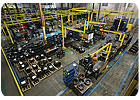
Between the growing demand for less expensive replacement parts and the cultural shift to conserve our natural resources, the North American remanufacturing industry is thriving.
Companies that remanufacture parts for cars, trucks, buses and tractors are faring particularly well. Just ask Doug Wolma, general manager of the remanufacturing business at ArvinMeritor Inc. “We’ve tripled our remanufacturing business in the past three years,” he says.
Business is so good, in fact, that in April 2009, the company opened a new 100,000-square-foot facility in Mississauga, ON, Canada. The facility remanufactures transmissions, axle carriers and steering gears for heavy trucks. It ships more than 1,200 axle carriers and transmissions each month.
The need for a new facility became apparent after ArvinMeritor acquired the remanufacturing company Mascot Truck Parts in December 2007. “Mascot had three facilities and a lot of waste,” Wolma recalls. “Lean manufacturing was not a strong suit. The new facility allowed us to consolidate those smaller facilities, which eliminated duplicate processes and nonvalue-adding activities. It also allowed us to ‘lean-out’ the whole manufacturing structure.”
Centralizing in one location enabled the company to reduce inventory, lower labor costs and boost productivity. As a result of the lean initiative, ArvinMeritor boosted production capacity for axle carriers and transmissions by 20 percent.
Whereas OEMs use steel, plastic and other raw materials to make their products, remanufacturers depend on a steady stream of used high-value assemblies, called cores in the industry. To ensure a fresh supply of cores, ArvinMeritor charges customers a deposit on remanufactured parts. When customers return the part that was replaced, they get the deposit back. ArvinMeritor also purchases cores from salvagers and other sources.
At the plant, incoming cores are completely disassembled down to individual piece parts, which then go through various cleaning processes to remove rust, dirt and debris. The goal is to get down to the base metal.
“Now, you can qualify the parts,” explains Wolma. “For every part in an assembly, we have a variety of specifications we check, such as surface finish, thickness and bore size.”
Some parts are reused, others are repaired, and some are scrapped. Some parts, such as bearings and seals, are never reused. Once all the parts are qualified, they are combined with new parts to produce a like-new remanufactured assembly. “Once you get to that point, there’s no difference between remanufacturing a part and assembling a brand new one,” says Wolma. “We use the same specs for assembly, test, paint and packaging.”
Disassembly is the most critical part of remanufacturing. “You won’t see a highly automated disassembly process at a remanufacturing plant,” says Wolma. “Pulling things apart is an art and a science. We use a lot of hand tools and special tools. We sometimes use a torch on parts to loosen them up. We use chemicals. If an axle carrier has been on the road for 300,000 or 400,000 miles, a lot of those fasteners are going to be corroded.”
The Mississauga facility isn’t the only facility in which ArvinMeritor has invested recently. The company has also pumped millions of dollars into a plant in Plainfield, IN, for remanufacturing brake shoes. The 300,000-square-foot facility employs 500 people and remanufactures 7 million brake shoes annually, up from 3.2 million just three years ago.
Editor’s note: “Moving Forward” is a regular series profiling new or expanding assembly plants. If you know a facility that’s opening, growing or investing in new equipment, we’d like to hear about it. Send an e-mail to John Sprovieri, editor of ASSEMBLY, at sprovierij@bnpmedia.com, or call 630-694-4012.